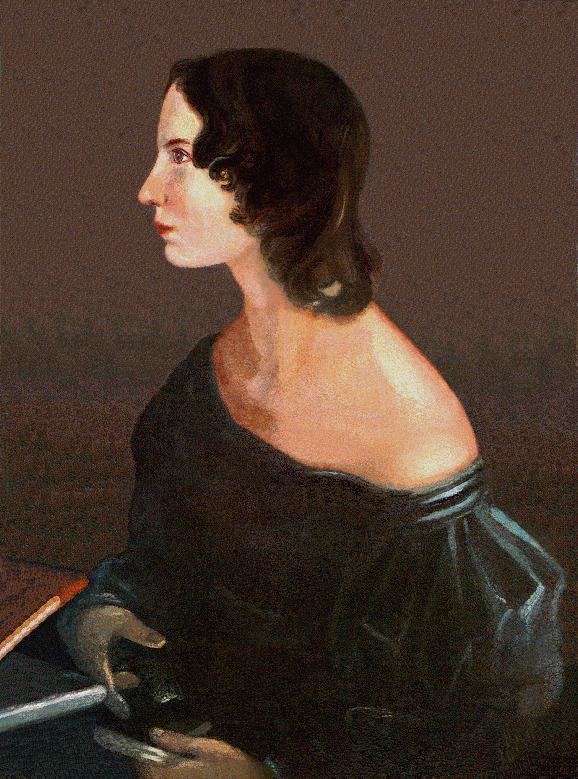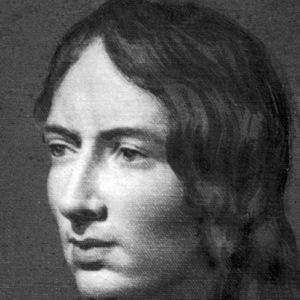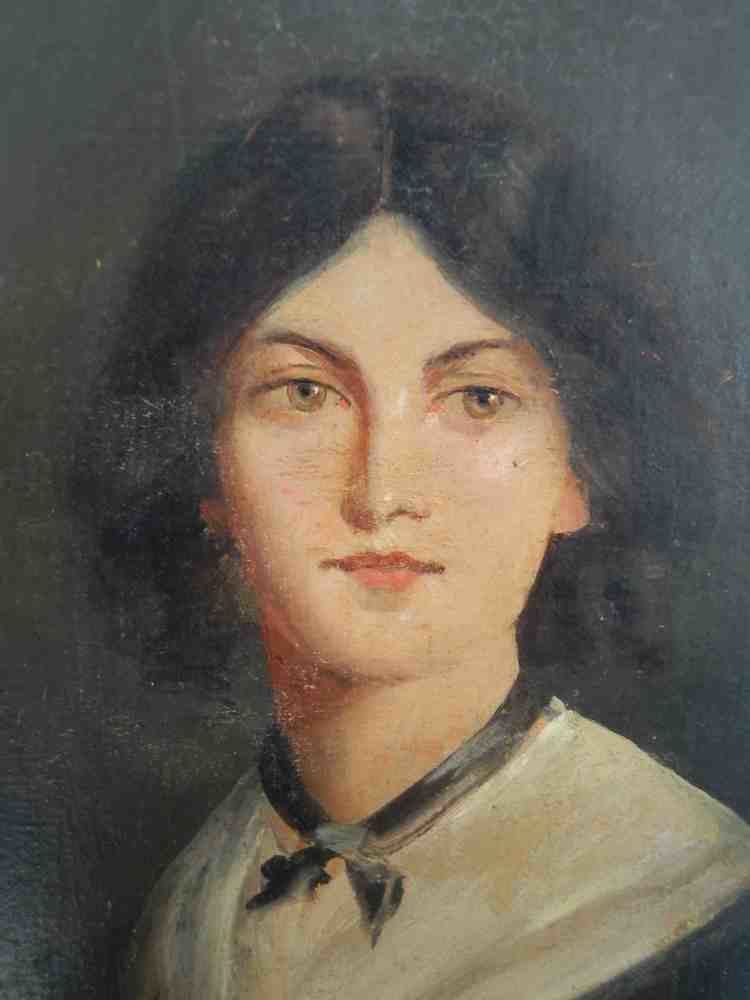Pen name Ellis Bell Nationality English Name Emily Bronte | Genre Fiction, poetry Role Novelist | |
 | ||
Occupation Poet, novelist, governess Siblings Charlotte Bronte, Anne Bronte, Branwell Bronte, Elizabeth Bronte, Maria Bronte Movies Emily Bronte\'s Wuthering Heights, Wuthering Heights, Hurlevent Books WUTHERING HEIGHTS, Poems by Currer - Ellis - and, The Bronte Sisters: Famous, Wuthering Heights & Jane Eyre, The Poems of Emily Bronte Similar People | ||
Literary movement Romantic Period | ||
Jane austen vs emily bront the queens of english literature debate
Emily Jane Brontë (/ˈbrɒnti/, commonly /ˈbrɒnteɪ/; 30 July 1818 – 19 December 1848) was an English novelist and poet who is best known for her only novel, Wuthering Heights, now considered a classic of English literature. Emily was the third-eldest of the four surviving Brontë siblings, between the youngest Anne and her brother Branwell. She wrote under the pen name Ellis Bell.
Contents
- Jane austen vs emily bront the queens of english literature debate
- Wuthering heights part 1 full audio book by emily bront part 1 of 2
- Early life and education
- Adulthood
- Personality and character
- Wuthering Heights
- Death
- Quotes
- References

Wuthering heights part 1 full audio book by emily bront part 1 of 2
Early life and education

Emily Brontë was born on 30 July 1818 in the village of Thornton on the outskirts of Bradford, in the West Riding of Yorkshire, in Northern England, to Maria Branwell and an Irish father, Patrick Brontë. She was the younger sister of Charlotte Brontë and the fifth of six children. In 1820, shortly after the birth of Emily's younger sister Anne, the family moved eight miles away to Haworth, where Patrick was employed as perpetual curate; here the children developed their literary talents.

After the death of their mother on 15 September 1821 from cancer, when Emily was three years old, the older sisters Maria, Elizabeth and Charlotte were sent to the Clergy Daughters' School at Cowan Bridge, where they encountered abuse and privations later described by Charlotte in Jane Eyre. At the age of six on 25 November 1824, Emily joined her sisters at school for a brief period. When a typhoid epidemic swept the school, Maria and Elizabeth caught it. Maria, who may actually have had tuberculosis, was sent home, where she died. Emily was subsequently removed from the school, in June 1825, along with Charlotte and Elizabeth. Elizabeth died soon after their return home.

The three remaining sisters and their brother Patrick Branwell were thereafter educated at home by their father and aunt Elizabeth Branwell, their mother's sister. Despite the lack of formal education, Emily and her siblings had access to a wide range of published material; favourites included Sir Walter Scott, Byron, Shelley, and Blackwood's Magazine.

In their leisure time the children began to write fiction at home, inspired by a box of toy soldiers Branwell had received as a gift and created a number of fantasy worlds (including 'Angria') which featured in stories they wrote – all "very strange ones" according to Charlotte – and enacted about the imaginary adventures of their toy soldiers along with the Duke of Wellington and his sons, Charles and Arthur Wellesley. Little of Emily's work from this period survives, except for poems spoken by characters. When Emily was 13, she and Anne withdrew from participation in the Angria story and began a new one about Gondal, a fictional island whose myths and legends were to preoccupy the two sisters throughout their lives. With the exception of their Gondal poems and Anne's lists of Gondal's characters and place-names, the writings on Gondal were not preserved. Some "diary papers" of Emily's have survived in which she describes current events in Gondal, some of which were written, others enacted with Anne. One dates from 1841, when Emily was twenty-three: another from 1845, when she was twenty-seven.

At seventeen, Emily attended the Roe Head Girls' School, where Charlotte was a teacher but managed to stay only a few months before being overcome by extreme homesickness. Charlotte later stated that: "Liberty was the breath of Emily's nostrils; without it she perished. The change from her own home to a school and from her own very noiseless, very secluded but unrestricted and unartificial mode of life, to one of disciplined routine (though under the kindest auspices), was what she failed in enduring... I felt in my heart she would die, if she did not go home, and with this conviction obtained her recall." She returned home and Anne took her place. At this time, the girls' objective was to obtain sufficient education to open a small school of their own.
Adulthood

Emily became a teacher at Law Hill School in Halifax beginning in September 1838, when she was twenty. Her health broke under the stress of the 17-hour work day and she returned home in April 1839. Thereafter she became the stay-at-home daughter, doing most of the cooking, ironing, and cleaning. She taught herself German out of books and also practised the piano.
In 1842, Emily accompanied Charlotte to the Héger Pensionnat in Brussels, Belgium, where they attended the girls' academy run by Constantin Héger. They planned to perfect their French and German in anticipation of opening their school. Nine of Emily's French essays survive from this period. Héger seems to have been impressed with the strength of Emily's character, and made the following assertion:
The two sisters were committed to their studies and by the end of the term had attained such competence in French that Madame Héger made a proposal for both to stay another half-year, even offering to dismiss the English master, according to Charlotte, so that she could take his place, while Emily was to teach music as she had by that time become a competent piano teacher. However, the illness and death of their aunt meant that they returned to Haworth and though they did try to open a school at their home, they were unable to attract students to the remote area.
In 1844, Emily began going through all the poems she had written, recopying them neatly into two notebooks. One was labelled "Gondal Poems"; the other was unlabelled. Scholars such as Fannie Ratchford and Derek Roper have attempted to piece together a Gondal storyline and chronology from these poems. In the autumn of 1845, Charlotte discovered the notebooks and insisted that the poems be published. Emily, furious at the invasion of her privacy, at first refused, but relented when Anne brought out her own manuscripts and revealed to Charlotte that she had been writing poems in secret as well. As co-authors of Gondal stories, Anne and Emily were accustomed to read their Gondal stories and poems to each other, while Charlotte was excluded from their privacy. Around this time she had written one of her the most famous poems "No coward soul is mine", probably as an answer to the violation of her privacy and her own transformation into a published writer. Despite Charlotte's later claim, it wasn't her last poem.
In 1846, the sisters' poems were published in one volume as Poems by Currer, Ellis, and Acton Bell. The Brontë sisters had adopted pseudonyms for publication, preserving their initials: Charlotte was "Currer Bell", Emily was "Ellis Bell" and Anne was "Acton Bell". Charlotte wrote in the 'Biographical Notice of Ellis and Acton Bell' that their "ambiguous choice" was "dictated by a sort of conscientious scruple at assuming Christian names positively masculine, while we did not like to declare ourselves women, because... we had a vague impression that authoresses are liable to be looked on with prejudice". Charlotte contributed 19 poems, and Emily and Anne each contributed 21. Although the sisters were told several months after publication that only two copies had sold, they were not discouraged (of their two readers, one was impressed enough to request their autographs). The Athenaeum reviewer praised Ellis Bell's work for its music and power, singling out his poems as the best: "Ellis possesses a fine, quaint spirit and an evident power of wing that may reach heights not here attempted", and The Critic reviewer recognised "the presence of more genius than it was supposed this utilitarian age had devoted to the loftier exercises of the intellect."
Personality and character
Emily Brontë remains a mysterious figure and a challenge to biographers because information about her is sparse, due to her solitary and reclusive nature. She does not seem to have made any friends outside her family. Her closest friend was her sister Anne. Together they shared their own fantasy world, Gondal, and, according to Charlotte's friend Ellen Nussey, in childhood they were "like twins", "inseparable companions" and "in the very closest sympathy which never had any interruption". In 1845 Anne took Emily to visit some of the places she had come to know and love in the five years she spent as governess. A plan to visit Scarborough fell through and instead the sisters went to York where Anne showed her sister York Minster. During the trip Emily and Anne acted out some of their Gondal characters.
Charlotte Brontë remains the primary source of information about Emily, although as an elder sister, writing publicly about her shortly after her death, she is not a neutral witness. Stevie Davies believes that there is what might be called Charlotte's smoke-screen and argues that Emily evidently shocked her, to the point where she may even have doubted her sister's sanity. After Emily's death, Charlotte rewrote her character, history and even poems on a more acceptable (to her and the bourgeois reading public) model. According to Lucasta Miller, in her analysis of Brontë biographies, "Charlotte took on the role of Emily's first mythographer." In the Preface to the Second Edition of Wuthering Heights, in 1850, Charlotte wrote:
Emily's unsociability and extremely shy nature have subsequently been reported many times. According to Norma Crandall, her "warm, human aspect" was "usually revealed only in her love of nature and of animals". In a similar description, Literary news (1883) states: "[Emily] loved the solemn moors, she loved all wild, free creatures and things", and critics attest that her love of the moors is manifest in Wuthering Heights. Over the years, Emily's love of nature has been the subject of many anecdotes. A newspaper dated 31 December 1899, gives the folksy account that "with bird and beast [Emily] had the most intimate relations, and from her walks she often came with fledgling or young rabbit in hand, talking softly to it, quite sure, too, that it understood". The following anecdote is also related:
In Queens of Literature of the Victorian Era (1886), Eva Hope summarises Emily's character as "a peculiar mixture of timidity and Spartan-like courage", and goes on to say, "She was painfully shy, but physically she was brave to a surprising degree. She loved few persons, but those few with a passion of self-sacrificing tenderness and devotion. To other people's failings she was understanding and forgiving, but over herself she kept a continual and most austere watch, never allowing herself to deviate for one instant from what she considered her duty."
Wuthering Heights
Emily Brontë's Wuthering Heights was first published in London in 1847, appearing as the first two volumes of a three-volume set that included Anne Brontë's Agnes Grey. The authors were printed as being Ellis and Acton Bell; Emily's real name did not appear until 1850, when it was printed on the title page of an edited commercial edition. The novel's innovative structure somewhat puzzled critics.
Wuthering Heights's violence and passion led the Victorian public and many early reviewers to think that it had been written by a man. According to Juliet Gardiner, "the vivid sexual passion and power of its language and imagery impressed, bewildered and appalled reviewers." Even though it received mixed reviews when it first came out, and was often condemned for its portrayal of amoral passion, the book subsequently became an English literary classic.
Although a letter from her publisher indicates that Emily had begun to write a second novel, the manuscript has never been found. Perhaps Emily, or a member of her family, eventually destroyed the manuscript, if it existed, when she was prevented by illness from completing it. It has also been suggested that, though less likely, the letter could have been intended for Anne Brontë, who was already writing The Tenant of Wildfell Hall, her second novel.
Death
Emily's health probably was weakened by the harsh local climate and by unsanitary conditions at home, the source of water being contaminated, by runoff, from the church's graveyard. Branwell died suddenly, on Sunday, September 24, 1848. At his funeral service, a week later, Brontë caught a severe cold which quickly developed into inflammation of the lungs and led to tuberculosis. Though her condition worsened steadily, she rejected medical help and all offered remedies, saying that she would have "no poisoning doctor" near her. On the morning of 19 December 1848, Charlotte, fearing for her sister, wrote this:
At noon, Emily was worse; she could only whisper in gasps. With her last audible words she said to Charlotte, "If you will send for a doctor, I will see him now" but it was too late. She died that same day at about two in the afternoon. According to Mary Robinson, an early biographer of Emily, it happened while she was sitting on the sofa. However, Charlotte's letter to William Smith Williams where she mentions Emily's dog lying at the side of her dying-bed, makes this statement seem unlikely.
It was less than three months since Branwell's death, which led Martha Brown, a housemaid, to declare that "Miss Emily died of a broken heart for love of her brother". Emily had grown so thin that her coffin measured only 16 inches wide. The carpenter said he had never made a narrower one for an adult. She was interred in the Church of St Michael and All Angels family capsule, Haworth, West Yorkshire, England. Emily Brontë never knew the extent of fame she achieved with her only novel, as she died a year after its publication, aged 30.
Quotes
Whatever our souls are made of - his and mine are the same
I see heaven's glories shine and faith shines equal
A person who has not done one half his day's work by ten o'clock - runs a chance of leaving the other half undone
